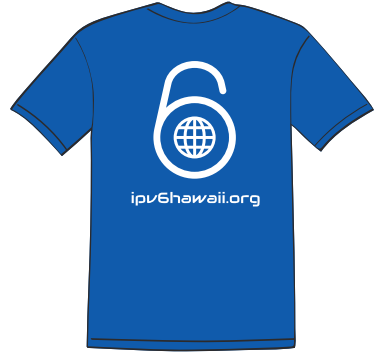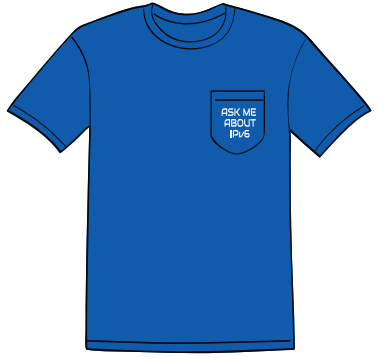IT’S DIFFICULT to determine when, exactly, IPv6 advocacy became intertwined, in the minds of the public, with haute couture. Accounts of our run-ins with paparazzi need not be expounded here. Suffice it to say: for many of us, it may be time to get back to basics.
ENTER: The “Ask Me” Pocket-T
Maybe you reached this page because you’d like to be the person wearing the AMPT, daring people to ask you about IPv6. If you are attending Internet2 Technology Exchange, September 18-22, 2023 in Minneapolis, Minnesota, then you can obtain the T by dropping an email to tshirt@ipv6hawaii.org (first come first served, while supplies last). Tell us a little bit about yourself, and your commitment to spreading the word about IPv6, and I will try to accommodate you, within the constraints of time, spatial proximity, causality, and hand one to you in person. If you are somewhere and/or somewhen other than that, I reserve the right to collect shipping and handling. At any rate: tshirt@ipv6hawaii.org
Maybe you saw someone wearing the t-shirt, and you didn’t get to ask them. The finer points follow. (If you’re a prospective ask-ee, reading on is not cheating)
You Should Have Deployed It By Now
IPv6 is ready and is used by millions of end-users every day, mostly un-noticed. This is because ISPs, corporations, universities, research organizations have brought it to users, and Big Content (Google, Facebook, Netflix, Akamai, Cloudflare, Limelight, Apple, Microsoft, etc) send those users content in IPv6. It is tried, tested, proven, and ready to be your L3 protocol of choice.
What Are IPv6’s Vital Statistics?
IPv6 is more than just a 128 bit address. In the 1990s as the internet increased in popularity and size, it was recognized that there were a few problems with IPv4 that the Internet Engineering Task Force (IETF) wanted to correct in the next version of Internet Protocol (IP).
Fixes To IPv4
Some of the items that were fixed in IPv6 are:
- Elimination of broadcasts: Since every host on a network must listen to broadcasts, it would steal CPU processing time away from the host. A broadcast storm would literally lock up every host on the network.
- Create a globally unique address without requiring a server: DHCPv4 was still young in the 1990s and people weren’t sure it would scale well. IPv6 has a method, called stateless address autoconfiguration (SLAAC) by which it can create a globally unique address without every contacting a server.
- Elimination of ARP: ARP uses broadcast, and since broadcast was eliminated, Neighbour Discovery (ND) was created. The requirement for IP to MAC address resolution is still required in IPv6, but rather than asking everyone, a small subgroup of multicast listeners are queried to resolve the MAC address.
- Duplicate Address Detection (DAD): In an IPv4 network, as duplicate address will cause a host to either a) ignore it and continue consuming packets destined for the other (duplicate) address, or take itself off line. neither are good solutions. IPv6 will run when it creates an address, by asking if there are any other hosts which have this address. If so, it will chose another address, and run DAD again. This eliminates duplicate IP addresses on the network.
- Creation of link-local address: Many of the above fixes require interactions on the network before obtaining/creating an Globally Unique Address (GUA). An IPv6 host will first create a link-local address, do DAD to ensure no other hosts are using that link-local address, and then do other functions, all without the requirement of a server or even a router on the local network.
More Addresses For Everything
Lastly, the creators of IPv4 thought 4 billion would be large enough for the internet, and they were right (for a while). But in the 1990s, it was clear that there would be more hosts on the internet than 4 billion. After all, how many devices do you have that can be on the internet? (include phones, laptops, tablets, IoT devices like thermostats, door bells, lights). And given that there are already 8 billion people on the planet, the IETF needed to create IP with larger address space.
An IPv6 address is 128 bits or 2^128, which in base 10 is: 340282366920938463463374607431768211456 or 3.4 X 10^39
That is much larger than the number of every grain of sand on every beach on the planet (5.6×10^21) or 18 more zeros (to the right).
It’s important to keep in mind that while the allocation of IPv4 addresses has always been enumerative, that is, providing a number of addresses that is adequate for a predicted need, the allocation of IPv6 address space has transcended that. The standard recommendation is to provide a block of 18,446,744,073,709,551,616 ( a /64) addresses to any LAN segment. Of course, that many devices will never share that LAN segment, so an IPv6 allocation is less of a group of addresses, and more of a canvas upon which addressing functionality can be painted. Address creation and assignment is one aspect of IPv6 operations that has evolved constantly since the initial deployments, and it will probably continue to evolve.
Someone Told Me That Almost Nobody Is Using IPv6. What About That?
There are various metrics available which show some percentage of global traffic that’s carried in IPv6, or the number of countries that have deployed IPv6, etc. While those metrics probably do represent the things that they claim to represent, understanding the uses of IPv6 on the modern Internet probably requires a different focus. Google’s oft-cited graph:
https://www.google.com/intl/en/ipv6/statistics.html
shows that in the last year, the growth in IPv6 enabled client requests to Google has increased by about 5 percentage points, and about 40 percentage points in the last 9 years, and growth continues, at about 5 points per year. On the other hand, the University of Hawaii operates a large academic WiFi network which has provided IPv4 and IPv6 to clients for over a decade, and has seen that the IPv6 traffic is about half of user traffic. This is because content providers are ready: Google, Netflix, Akamai, Limelight, Cloudflare, and other content/CDN providers have been providing their content in IPv6 for years.
The Salient Point
IPv6 is ready to access content, it’s already in your devices, and you can start deploying it now. Getting started positions you and your users for a better future than IPv4 can provide. Yes, you will probably need to provide IPv4 connectivity for a while, but the more IPv6-enabled users there are, the shorter that transitional period will be…
(This entreaty was entreated by Alan Whinery, most of the factual info was encoded by Craig Miller)

